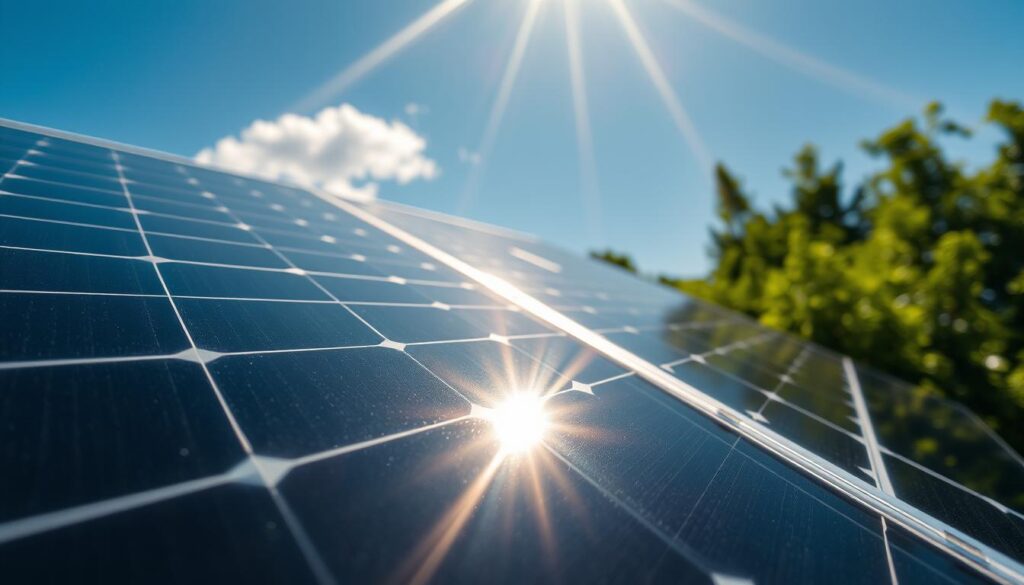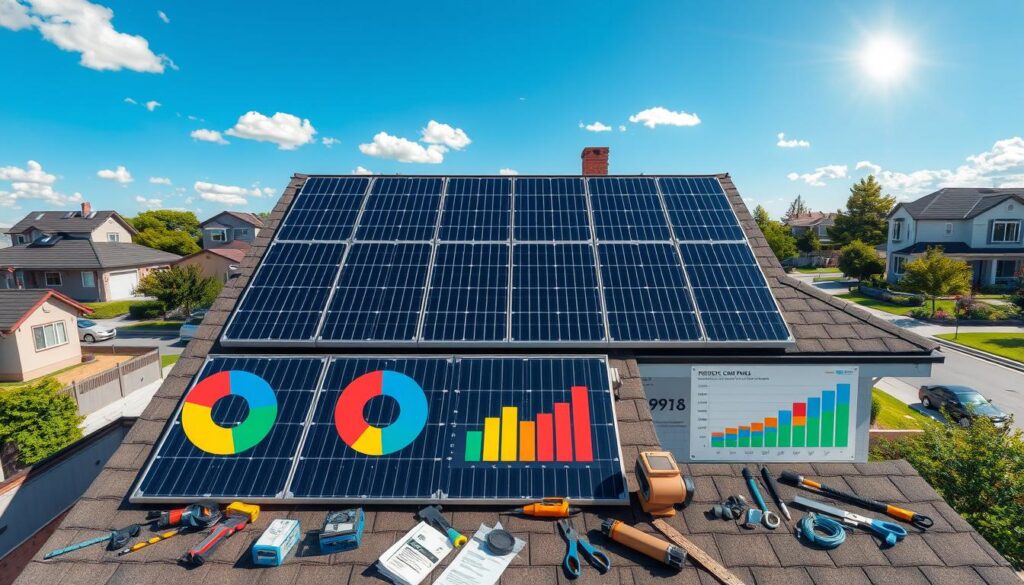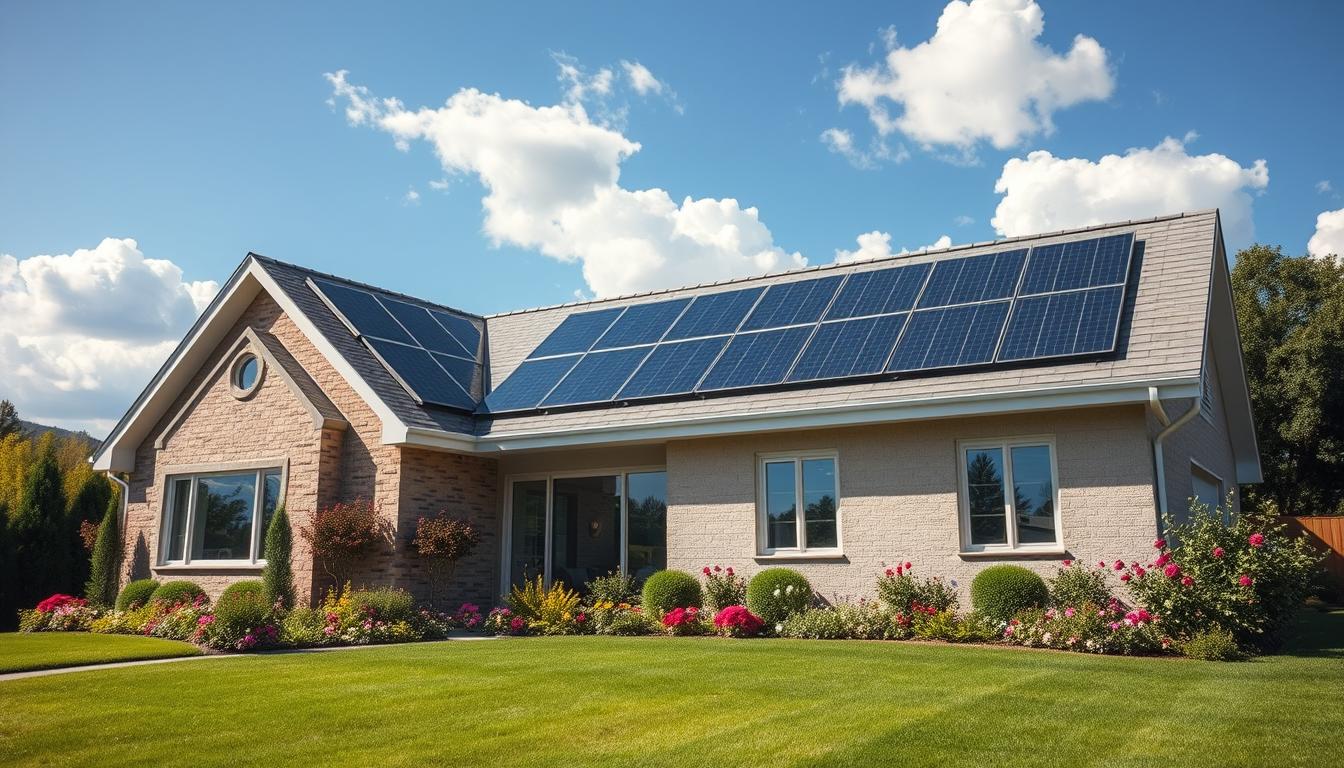Have you ever thought about using the sun’s power for your home? I’ve been really interested in how solar energy is becoming more common in homes. It’s great for the environment and can even lower your electricity bills. But, is it really as perfect as it seems?
Looking into residential solar panels, I see it’s not as simple as it seems. It’s not just putting panels on your roof. There are many things to think about, like the cost and how much energy you can make.
In this article, I’ll show you the bright side and the dark side of solar energy for homes. If you’re curious or want to help the planet, join me on this journey. We’ll explore the good and the bad of solar power for homes together.
Key Takeaways
- Solar power offers renewable, eco-friendly energy for homes
- Residential solar panels can significantly reduce electric bills
- Transitioning to solar energy involves complex decision-making
- Solar technology promotes energy independence for homeowners
- High initial costs and sunlight dependency are key considerations
- Government incentives may offset some solar installation expenses
The Rise of Solar Energy in Residential Homes
I’ve seen a big change in how we use energy. Solar power is now a real option for homes in America. The growth in the solar energy market is amazing.
Growing popularity of solar technology
More people are choosing solar power for their homes. In fact, the number of solar systems installed has doubled in five years. It’s easy to see why – it saves money and helps the planet.
Integration in commercial and residential settings
Businesses are also turning to solar power. You can see solar panels on farms and rooftops everywhere. This growth is taking the solar energy market to new levels.
The complexity of transitioning to solar power
Switching to solar isn’t easy. You have to think about costs, energy needs, and more. But, many companies are making it easier to go solar.
| Year | Residential Solar Installations (GW) | Market Growth (%) |
|---|---|---|
| 2018 | 2.5 | 15 |
| 2019 | 2.8 | 12 |
| 2020 | 3.2 | 14 |
| 2021 | 4.2 | 31 |
| 2022 | 5.3 | 26 |
The numbers show solar power is here to stay. As technology gets better and costs go down, I think this trend will keep growing. The future of energy looks very bright!
Understanding Solar Energy: From Sunlight to Electricity
I’ve always been fascinated by solar energy. It’s like nature’s own power plant, turning sunlight into electricity. Let’s explore how this magic happens!

At the heart of solar panels are photovoltaic cells. These tiny powerhouses are the real MVPs. Made from materials like silicon, they’re the worker bees that make the hive buzz.
When sunlight hits these cells, it starts a process that would impress Einstein. The photons in sunlight knock electrons loose, creating an electric current. It’s like a microscopic game of pool, where light is the cue ball and electrons are the balls bouncing around.
Solar energy is like turning your roof into a miniature power plant, but instead of smokestacks, you get savings!
The efficiency of this energy conversion depends on a few factors. Location is key – the more sun, the merrier. That’s why you’ll often see solar panels on rooftops or in open fields. It’s all about maximizing sunlight exposure.
| Component | Function | Fun Fact |
|---|---|---|
| Photovoltaic Cells | Convert sunlight to electricity | Can work even on cloudy days! |
| Inverter | Converts DC to AC power | The unsung hero of solar systems |
| Battery | Stores excess energy | Your personal power bank |
So next time you see a house with solar panels, you’ll know there’s science at work. It’s not just about looking cool (though that’s nice). It’s about harnessing the sun’s power to light up our world!
Environmental Impact: A Greener Alternative
I’m excited to explore the world of solar energy! As someone who loves clean energy, I’ve seen how solar is changing our planet. It’s a key player in the fight against climate change.
Slashing Carbon Emissions
Solar power is a big win for our planet. It uses the sun’s energy, reducing greenhouse gases. The numbers show it’s making a big difference:
| Energy Source | CO2 Emissions (g/kWh) |
|---|---|
| Solar PV | 41 |
| Coal | 820 |
| Natural Gas | 490 |
Breaking Free from Fossil Fuels
Solar energy helps us move away from fossil fuels. It’s amazing how quickly solar panels can start saving our planet. They can power homes for decades after just a few years of installation!
Saving Every Drop
Solar energy also saves water. Unlike old power plants, solar panels don’t need much water. It’s like having a hero that fights climate change and saves water too!
“Solar energy isn’t just clean, it’s a powerhouse of sustainability that keeps on giving!”
Solar systems last 30 years or more. They’re a long-term gift to our planet. I believe choosing solar is one of the smartest decisions for a better future.
Financial Considerations of Solar Panel Installation
I’ve been looking into the costs of solar panels, and it’s a wild ride for your wallet. The first cost can be high, from $10,000 to $25,000 for a 5-kilowatt system. But don’t worry, it’s worth it!

Now, let’s look at the bright side. Solar panels can save you a lot of money on electricity. Your electric bills will drop fast. Plus, homes with solar panels sell for 4.1% more, on average. That’s a $9,274 boost for the median-value home.
When it comes to getting your money back, solar panels have a good track record. You can expect to see your investment pay off in 6 to 10 years. After that, you’ll save money for years to come.
| Investment | Potential Savings | Home Value Increase |
|---|---|---|
| $10,000 – $25,000 | Significant monthly bill reduction | 4.1% ($9,274 on average) |
While the initial cost of solar panels is high, the long-term savings and increased home value are worth it. It’s like having a money tree on your roof that keeps giving!
Energy Independence and Grid Interaction
I’ve found that solar power systems do more than just clean up our energy. They lead to energy self-sufficiency. Let’s explore how these systems can change your home’s power.
Off-grid Living
Imagine never having to think about power bills again. Solar panels and batteries let me power my home on my own. It’s like having a mini power plant at home. This setup means I can live off-grid, without relying on utility companies.
Selling Power Back
Grid-tied solar systems have a cool feature. On sunny days, my panels make more electricity than I use. Instead of wasting it, I can sell it back to the grid. It’s like running my own energy business from my roof!
Backup During Blackouts
Solar systems also protect me from power outages. When the grid fails, my lights stay on. It’s comforting to know I have a backup during storms or emergencies. No more searching for flashlights or worrying about food going bad in the fridge.
- Achieve energy independence
- Reduce or eliminate electricity bills
- Earn money by selling excess power
- Stay powered during grid outages
Solar energy systems lead to true energy independence. They offer financial savings, environmental benefits, and peace of mind. It’s no surprise more homeowners are switching to solar power.
The Benefits and Drawbacks of Homes Powered by Solar Energy
Exploring solar energy, I see both good and bad sides for homeowners. Let’s look at the pros and cons of solar power.
Advantages: Shining Bright
Solar power is a renewable energy that keeps giving. It cuts down electric bills, saving money and increasing home value. Plus, it’s easy to maintain, making it a smart long-term choice.
Disadvantages: Cloudy Considerations
But solar energy has its downsides. The start-up costs are high, and it doesn’t work well on cloudy days. Also, you need enough space for the panels.
| Pros | Cons |
|---|---|
| Renewable energy source | High upfront costs |
| Reduced electricity bills | Weather-dependent efficiency |
| Increased home value | Space requirements |
| Low maintenance | Potential relocation difficulties |
Even though solar panel efficiency is getting better, it’s important to think about these points. For many, the long-term gains make solar a great choice for the future.
Maintenance and Longevity of Solar Panel Systems
I’ve lived with solar panels for years, and they’re easy to care for. They just sit there, catching the sun and making electricity. But, a little care can make them last longer.
Keeping your solar panels in good shape is simple. A yearly clean and check are all you need. Professional cleaners charge about $150 for this service. It’s worth it to keep your panels working well.

Now, let’s talk about how well solar panels work over time. Good news: most panels come with a 25-year warranty. This means your investment is safe for a long time.
| Maintenance Task | Frequency | Average Cost |
|---|---|---|
| Professional Cleaning | Annually | $150 |
| Inspection | Annually | $150 |
| Panel Servicing | As needed | $140-$180 |
Consistency is key to making your solar panels last. Regular checks catch problems early. Your wallet will also appreciate it. So, here’s to sunny days and a bright future!
Technological Advancements and Future Prospects
I’m excited about the future of solar power. The pace of solar innovation is quickening, promising a brighter tomorrow for clean energy. Let’s explore the cutting-edge developments shaping the future of solar power.
Improving Efficiency of Solar Panels
Solar panels are getting better at turning sunlight into electricity. New materials and designs are pushing the limits of what’s possible. I’ve seen panels that can now convert over 25% of sunlight into power, a big jump from just a few years ago.
Decreasing Costs of Solar Technology
The price tag on solar tech is dropping fast. As more people go solar, production scales up and costs come down. It’s a virtuous cycle that’s making solar more affordable for everyone. I remember when solar was a luxury, but now it’s becoming a smart choice for many homeowners.
Innovations in Energy Storage Solutions
Energy storage advancements are solving solar’s biggest challenge: what to do when the sun isn’t shining. New battery technologies are game-changers. They’re getting cheaper, lasting longer, and storing more power. This means solar-powered homes can stay lit up even after dark.
| Technology | Current Status | Future Potential |
|---|---|---|
| Solar Panel Efficiency | 20-22% average | 30-35% expected |
| Solar Panel Cost | $2.50-$3.50 per watt | $1.50-$2.00 per watt |
| Battery Storage Capacity | 10-13 kWh typical | 20-30 kWh projected |
With these advancements, I’m confident that solar power will play an even bigger role in our energy future. It’s an exciting time to watch this technology evolve and reshape how we power our lives.
Government Incentives and Solar Energy Policies
Hey, sun-loving homeowners! The U.S. government is excited about solar energy. They’re offering a 30% tax credit on solar panel costs from 2022 to 2032. It’s like they’re inviting you to go solar!
But there’s more! Some states are giving out Solar Renewable Energy Credits (SRECs) like candy. Plus, many offer property tax exemptions for solar installations. It’s a big thank you for saving the planet.
These incentives are not just about saving money. They’re part of a bigger plan for a cleaner future. The government is encouraging us to use renewable energy. So, why not turn your roof into a power plant? Your wallet and the planet will thank you!
FAQ
What are the main benefits of installing solar panels for homes?
How much do residential solar panel systems typically cost?
How do solar panels generate electricity from sunlight?
What is the environmental impact of using solar energy?
How long does it take for a solar panel system to pay for itself?
How can solar panel systems provide energy independence?
What are some drawbacks of using solar energy for homes?
How long do solar panels typically last?
What kind of maintenance do solar panels require?
What kind of maintenance do solar panels require?
What incentives are available for homeowners to install solar panels?
Source Links
- The Advantages and Disadvantages of Solar Energy – https://www.constellation.com/energy-101/energy-innovation/solar-energy-pros-and-cons.html
- Solar Energy Pros And Cons: What Are The Advantages And Disadvantages? – https://www.forbes.com/home-improvement/solar/solar-energy-pros-and-cons/
- Pros and Cons of Solar Panels: Worth It or Not? – NerdWallet – https://www.nerdwallet.com/article/mortgages/pros-and-cons-of-solar-panels-worth-it-or-not




Interesting read, but arent we ignoring the eyesore these solar panels can be on our beautiful homes? Aesthetics matter, folks!
I feel solars great, but what about the environmental impact of manufacturing and disposing of the panels? Are we just shifting the problem?
Does the increasing solar tech popularity really balance out the initial high costs and the inconsistent energy supply problems?
Absolutely, initial costs are high but long-term savings and environmental benefits certainly outweigh the drawbacks.
Interesting read, but are we considering the impact of solar panel production on the environment? Whats the balance here?
Interesting points, but have we considered the impact of solar panel disposal on the environment? Its not all sunshine and rainbows, folks!